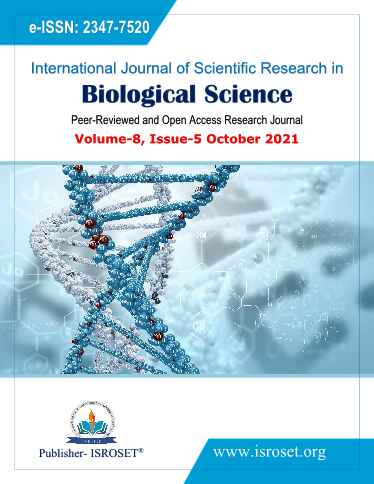Morphological Alterations in Haemocytes of Adult American Cockroach, Periplaneta americana (Linnaeus) (Insecta: Blattodea: Blattidae) in Response to Thermal Stress and Induced Infection
Keywords:
Haemocyte, Morphology, Thermal stress, Infection, CockroachAbstract
American cockroaches (Periplaneta americana) are considered as potential vectors and possible reservoirs of pathogenic organisms. They respond to any infection by mounting immune responses mediated by morphologically and functionally distinct haemocytes. To understand the effect of abiotic stress like heat, cold and biotic stress induced by infection on American cockroahes, microscopic study of haemocytes was carried out from adult P. americana (Linnaeus) (Insecta: Blattodea: Blattidae). In the present study, morphological alterations of haemocytes were observed at high temperature (45°C for 12 hours), low temperature (4°C for 12 hours) and following inoculation with E. coli bacteria compared to the control haemocytes. Stress induced necrotic changes of haemocytes like loss of cellular integrity, vacuolization, cell swelling, blebbing, margination of chromatin, membrane rupture were recorded in all the three types of stress conditions. The most affected haemocytes were Plasmatocytes, Granulocytes and Prohaemocytes. Unusual nuclear separation in a cap like bleb formation and margination were observed at low temperature. Cellular aggregation and phagocytic extensions of Granulocytes and Plasmatocytes were visible after induced infection. This is the first study where the changes in the primitive immune cells of American cockroaches have been reported in response to abiotic and biotic stress. Hemocyte structural modifications and changes observed in the present study have potential implications in the study of stress response in P. americana in the extreme environment and in destruction of pathogens. Cellular aggregation and phagocytosis are characteristics defence reactions which are not found in thermal stressed cells. Although vacuolization, blebbing and chromatin margination were common alterations in response to all types of stresses applied in this study.
References
V.B.Wigglesworth, “The physiology of the cuticle and ecdysis in Rhodnius prolixus (Triatomidae, Hemiptera), with special reference to the function of the oenocytes and the dermal glands,” Journal of Microscopical Science, Vol. 76, pp.269-319, 1933.
J.C.Jones, “Current concepts concerning insect haemocytes,” American Zoologist, Vol.2, pp. 209-246, 1962. https://doi.org/10.1093/icb/2.2.209
A.P.Gupta, “Insect hemocytes development, forms, functions and techniques,” Cambridge University Press, New York, 1979a.
P.R.Mangalika, T. Kawamoto, A.Takahashi-Nakaguchi, K.Iwabuchi, “Characterization of cell clusters in larval hemolymph of the cabbage armyworm Mamestra brassicae and their role in maintenance of hemocyte populations,” Jornal of Insect Physiology, Vol. 56, pp. 314-323, 2010. doi: 10.1016/j.jinsphys.2009.11.003. Epub 2009 Nov 21.
C. Ribeiro, M.Brehelin, “Insect haemocytes: What type of cell is that?,”Jornal of Insect Physiology, Vol.52,417429,2006.https://doi:10.1016/j.jinsphys.2006.01.005
M.D.Lavine, M.R.Strand, “Insect hemocytes and their role in immunity,” Insect Biochemistry and Molecular Biology, Vol.32, pp.1295-1309, 2002. https://doi.org/10.1016/S0965-1748 (02)00092-9
M.A. Khan, “Haemocytes of Indian insects. In: Advances in insect physiology, morphology and ecology. Todays and tomorrows” eds. S.C. Pathak and Y.N. Sahai, New Delhi, 1986
D.M.Guthrie, A.R. Tindall, “The Biology of the Cockroach,” Edmond Arnorl, London, 1968.
W.J Bell, K.G. Adiyodi, “The American cockroach,” Chapman & Hall Ltd, New York, 1982.
R.J.Boerwald, “Inverted gap and other cell junctions in Cockroach haemocyte capsules: A thick section and freeze-fracture study,” Tissue Cell, Vol. 7, pp.575-585, 1975.
P.T.Brey, “The impact of stress on insect immunity,” Bulletin de l’Institut Pasteur, Vol. 92, No., 2, pp. 101-118, 1994.
C.Parmesan, T.L. Root, M.R. Willig, “Impacts of extreme weather and climate on terrestrial biota” Bulletin of the American Meteorological Society, Vol. 81, pp.443–450, 2000.
R.F. Chapman, “The Insects: Structure and Function,” Cambridge University Press, Cambridge, pp. 242-386, 2002.
K.Mellanby, “Low temperature and insect activity,” Proceedings of the Royal Society B: Biological Sciences, Vol.127, pp.473-487, 1939. https://doi.org/10.1098/rspb.1939.0035
R. Loftus,“Cold receptor on the antennae of Periplaneta americana,” J Vergleichende Physiol, Vol.52,380,1966.https://doi.org/10.1007/BF00302292
K.Tanaka, S. Tanaka, “Winter survival and freeze tolerance in a northern cockroach, Periplaneta japonica (Blattidae: Dictyoptera),” Zoological Science, Vol. 14, 849-853, 1997. https://doi.org/10.2108/zsj.14.849
J.P. Pandey, P.K. Mishra, D.Kumar, B.M.K. Singh, B.C. Prasad, “Effects of temperature on hemocytic immune responses of tropical tasar silkworm Antheraea mylitta D, Research Journal of Immunology, Vol.3, pp.169-177, 2010. https://dx.doi.org/10.3923/rji.2010.169.177
M.Ryan, W.L. Nicholas, “The reaction of the cockroach Periplaneta americana to the injection of foreign particulate material,” Journal of Invertebrate Pathology, Vol. 19, pp.299-307, 1972.https://doi.org/10.1016/0022-2011 (72) 90226-1
H.H. Awad, “Effects of Bacillus thuringiensis and farnesol on hemocytes response and lysozymal activity of the Black Cut Worm Agrotis ipsilon larvae,” Asian Journal of Biological Sciences, Vol. 5, pp. 157-170, 2012. https://dx.doi.org/10.3923/ajbs.2012.157.170
T.Kiuchi, F.Aoki, M.Nagata, “Effects of high temperature on the hemocyte cell cycle in silkworm larvae,” Journsl of Insect Physiology, Vol.54, pp.454-461, 2008.
J.F.Yeager,“The blood picture of the southern armyworm (Prodenia eridania),”Journal of Agricultural Research, Vol. 71, pp.1-40, 1945.
J.W. Arnold, “A comparative study of the haemocytes (blood cells) of cockroaches (Insecta: Dictyoptera: Blattaria), with a view of their significance in taxonomy,” The Canadian Entomologists, Vol. 104, pp.309-348, 1972a. https://doi.org/10.4039/Ent104309-3
D.L.Bradt, W.W.Hoback, B.M.Kard, “American Cockroach Response to Cold Temperatures” Southwestern Entomologist, Vol. 43, No., 2, pp.335-343, 2018. https://doi.org/10.3958/059.043.0205
M.T.Scott, “Recognition of foreignness in invertebrates. II. In vitro studies of cockroach phagocytic haemocytes,”Immunity, Vol. 21, pp.817-828, 1971.
E.M.M.Gardiner, M.R Strand, “Monoclonal antibodies bind distinct classes of hemocytes in the moth, Pseudoplusia includens,” Journal of Insect Physiology, Vol. 45, pp. 113–126, 2000.
Downloads
Published
How to Cite
Issue
Section
License

This work is licensed under a Creative Commons Attribution 4.0 International License.
Authors contributing to this journal agree to publish their articles under the Creative Commons Attribution 4.0 International License, allowing third parties to share their work (copy, distribute, transmit) and to adapt it, under the condition that the authors are given credit and that in the event of reuse or distribution, the terms of this license are made clear.







